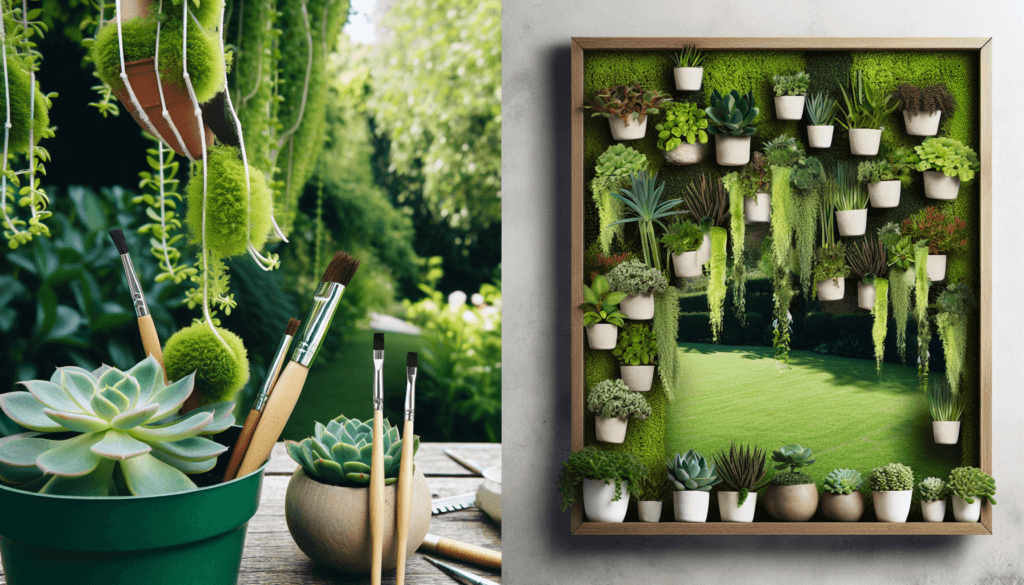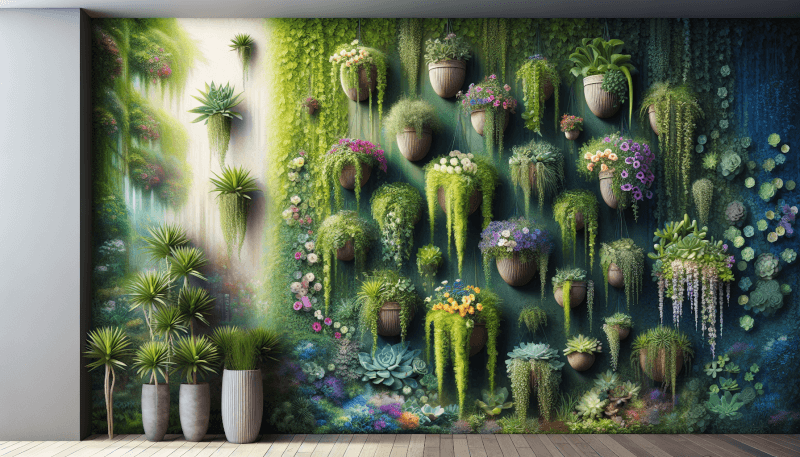Ready to add a touch of greenery to your living space? Look no further than our DIY guide to creating a vertical garden. Whether you have a small balcony or a spacious backyard, this article will walk you through the steps to transform any vertical surface into a thriving oasis of plants. From choosing the right plants and materials to understanding the proper irrigation techniques, we’ve got you covered. Get ready to unleash your inner gardener and create a stunning vertical garden that will be the envy of all your neighbors.

Choosing the Right Location for Your Vertical Garden
Assessing available space
When choosing the location for your vertical garden, it’s important to assess the available space you have. Consider the dimensions of the area, including both the width and height, as vertical gardens can take advantage of unused vertical space. Look for a location that can accommodate the size and structure of your vertical garden without obstructing pathways or other essential areas.
Considering sunlight and shade
The amount of sunlight and shade that the location receives is crucial for the success of your vertical garden. Most plants require a certain amount of sunlight to thrive, so choose a spot that receives adequate light throughout the day. However, be aware of any potential shading from nearby trees, buildings, or structures that could cast shadows and limit the amount of sunlight reaching your vertical garden.
Evaluating accessibility for maintenance
Maintenance is an essential aspect of vertical gardening, so it’s important to choose a location that is easily accessible for regular care and upkeep. Consider how far the garden will be from a water source, as you’ll need to water your plants regularly. Additionally, factor in how easy it will be to reach the plants for pruning, fertilizing, and any other necessary maintenance tasks.
Taking into account structural support
Vertical gardens can become quite heavy, especially when fully grown and filled with soil and plants. It is crucial to assess the structural support of the chosen location to ensure it can handle the weight of your vertical garden. Consider the type of wall or structure you plan to attach your vertical garden to, and if needed, consult a professional to ensure it is sturdy enough to support the weight.
Selecting Suitable Plants for Your Vertical Garden
Choosing plants that thrive in vertical gardens
Not all plants are suitable for vertical gardens, so it’s important to choose ones that are well-suited to vertical growing. Look for plants that have a compact growth habit and can thrive in a confined space. Examples of suitable plants for vertical gardens include herbs like basil and oregano, lettuce, strawberries, and certain varieties of succulents.
Selecting plants based on light requirements
Different plants have varying light requirements, so it’s important to choose plants that are compatible with the amount of sunlight your chosen location receives. Some plants thrive in full sun, while others prefer more shade. Research the light requirements of the plants you’re interested in and make sure they align with the conditions of your vertical garden’s location.
Considering the desired aesthetic and function
When selecting plants for your vertical garden, consider both the desired aesthetic and function of your garden. Think about the colors, textures, and heights of the plants you want to incorporate to create an appealing visual display. Additionally, consider if you want your vertical garden to serve a specific purpose, such as growing edible plants or herbs, and select plants accordingly.
Understanding the growth habits of the chosen plants
It’s essential to have a good understanding of the growth habits of the plants you choose for your vertical garden. Some plants may spread and grow vigorously, which may not be ideal for a limited vertical space. Consider the potential height and spread of each plant to ensure they won’t overcrowd or overshadow each other as they grow.

Preparing Your Vertical Garden Structure
Determining the type of vertical structure
There are various types of vertical structures to choose from when creating your vertical garden. Some common options include trellises, living walls, pallet gardens, and modular panels. Consider the available space, your aesthetic preferences, and the types of plants you’ll be growing when determining the best type of vertical structure for your garden.
Choosing the right materials
Selecting the right materials for your vertical garden structure is crucial for durability and functionality. Consider materials that are weather-resistant, such as treated wood or metal, to ensure longevity. Additionally, choose materials that are lightweight yet sturdy, as they will need to support the weight of the plants and soil.
Assembling the vertical frames or panels
Once you have chosen the type of vertical structure and gathered the necessary materials, it’s time to assemble the frames or panels. Follow the manufacturer’s instructions or consult a DIY guide specific to your chosen structure type. Take care to ensure that all pieces fit securely and that the structure is level and sturdy.
Ensuring proper drainage for the structure
Proper drainage is essential for the health of your vertical garden. Ensure that your chosen structure allows water to drain freely and doesn’t accumulate excess moisture. Consider incorporating drainage holes or a layer of gravel at the bottom of the structure to prevent waterlogging and promote healthy root growth.
Preparing the Growing Medium
Understanding the importance of a suitable growing medium
The growing medium, or soil mix, you choose for your vertical garden plays a vital role in providing plants with the necessary nutrients, water, and aeration. Opt for a lightweight and well-draining soil mix that will allow excess water to flow through without becoming waterlogged. Avoid using heavy clay-based soils, as they can lead to drainage issues and hinder plant growth.
Creating a lightweight and well-draining soil mix
To create a suitable soil mix for your vertical garden, combine equal parts of potting soil, perlite or vermiculite for aeration, and coconut coir or sphagnum moss for moisture retention. This blend will provide a well-draining yet moisture-retentive growing medium that is ideal for vertical gardening. Adjust the proportions as needed based on the specific needs of your chosen plants.
Considering the addition of compost or organic matter
Adding compost or organic matter to your soil mix can improve its fertility and overall health. Consider incorporating well-rotted compost, aged manure, or worm castings into the soil mix to provide a steady supply of nutrients for your plants. This organic matter will also help improve soil structure and moisture retention, promoting healthier plant growth.
Ensuring proper pH levels for optimal plant growth
The pH level of the soil plays a crucial role in nutrient availability for plants. Most plants prefer a slightly acidic to neutral pH range. Test the pH of your soil mix using a soil pH testing kit and adjust it if necessary. If the pH is too high, you can lower it by adding elemental sulfur or sphagnum peat moss. If the pH is too low, you can raise it by adding garden lime.

Installing Your Vertical Garden
Attaching the vertical structure to the designated location
To install your vertical garden, carefully attach the vertical structure to the designated location. Depending on the type of structure, you may need screws, brackets, or hooks to secure it in place. Ensure that the structure is level and securely fastened to prevent any potential accidents or damage.
Ensuring stability and weight distribution
Once the vertical structure is attached, double-check its stability and weight distribution. Make sure it is strong enough to hold the weight of the plants and soil without leaning or tilting. If necessary, reinforce the structure or adjust the weight distribution by rearranging plants to provide a more balanced and stable vertical garden.
Arranging the planting pockets or modules
If your vertical garden utilizes planting pockets or modules, arrange them in an aesthetically pleasing and functional manner. Consider the growth habits and spacing requirements of your chosen plants when positioning them. Leave enough space between each pocket/module to allow proper air circulation and minimize competition between plants.
Connecting the water irrigation system
To ensure your vertical garden receives sufficient water, connect a water irrigation system if needed. This can be as simple as a drip irrigation system or a network of hoses with built-in sprinklers. Consider the specific watering requirements of your plants and adjust the irrigation system accordingly. Regularly check the system for any leaks or clogs to maintain consistent water distribution.
Maintaining Your Vertical Garden
Regularly monitoring soil moisture levels
Regularly monitor the moisture levels of your vertical garden’s soil to ensure your plants are receiving adequate hydration. Stick your finger into the soil to a depth of about one inch and check if it feels dry. Adjust your watering schedule accordingly to prevent under or overwatering, as both can negatively impact plant health.
Implementing a watering schedule
Establishing a consistent watering schedule is crucial for the health and vitality of your vertical garden. Consider the moisture requirements of your chosen plants and the specific conditions of your environment, such as humidity and temperature. Water your vertical garden at regular intervals, ensuring that the soil is thoroughly moistened without becoming waterlogged.
Feeding the plants with appropriate fertilizers
To promote healthy growth and development, feed your plants with appropriate fertilizers. Choose a balanced, slow-release fertilizer or organic alternatives to provide a steady supply of nutrients. Follow the manufacturer’s instructions for application rates and frequencies, and be careful not to overfertilize, as this can lead to nutrient imbalances and burn the plants’ roots.
Pruning and trimming the plants as needed
Regular pruning and trimming of the plants in your vertical garden are essential to maintain their shape, health, and aesthetics. Remove any dead, damaged, or diseased foliage to prevent the spread of pests or diseases. Additionally, trim back any overgrown or unruly growth to promote better air circulation and prevent overcrowding.

Dealing with Potential Pests and Diseases
Identifying common pests that target vertical gardens
It’s important to be aware of common pests that can target vertical gardens and take appropriate measures to control them. Common pests that may affect vertical gardens include aphids, spider mites, whiteflies, and snails/slugs. Regularly inspect your plants for any signs of pest infestation, such as visible damage, sticky residue, or unusual discoloration.
Using organic pest control methods
When combatting pests in your vertical garden, consider using organic pest control methods to minimize the use of harmful chemicals. Options include introducing beneficial insects like ladybugs or lacewings, using insecticidal soaps or horticultural oils, and implementing physical barriers like netting or traps. Research organic pest control techniques specific to the pests affecting your vertical garden.
Recognizing common diseases that affect vertical gardens
Vertical gardens, like any other type of garden, are susceptible to certain diseases. Common diseases that may affect your vertical garden include fungal infections, bacterial leaf spots, and powdery mildew. Regularly inspect your plants for any signs of disease, such as abnormal leaf spots, stunted growth, or fungal growth.
Taking preventive measures to avoid plant diseases
Prevention is key when it comes to plant diseases in vertical gardens. Ensure proper air circulation by avoiding overcrowding and regularly trimming back excess growth. Water your plants directly at the soil level to minimize moisture on the leaves, as this can encourage fungal growth. Additionally, avoid overhead watering, which can increase humidity levels and create a favorable environment for disease development.
Troubleshooting Common Vertical Garden Issues
Addressing inadequate plant growth
If you notice that your plants are not growing as expected in your vertical garden, several factors could be at play. Assess the amount of sunlight your plants are receiving and ensure it aligns with their light requirements. Check the soil moisture levels and adjust your watering schedule accordingly. If necessary, consider adjusting the plant selection to better suit the conditions of your vertical garden.
Dealing with overwatering or drainage problems
Overwatering or poor drainage can lead to root rot and other issues in your vertical garden. If you notice excessive moisture or waterlogging in the soil, adjust your watering schedule to allow for proper drainage. Consider adding more drainage holes or a layer of gravel at the base of the structure. If necessary, repot the affected plants into a well-draining soil mix to prevent further water-related problems.
Revitalizing wilted or unhealthy plants
Wilted or unhealthy plants in your vertical garden may be a sign of various issues, such as water stress, nutrient deficiencies, or pest/disease problems. Take immediate action by adjusting the watering schedule, providing adequate nutrients through fertilization, and addressing any pest or disease issues. Prune away any dead or damaged foliage to redirect energy to healthier growth.
Replacing or relocating plants if necessary
In some cases, you may need to replace or relocate plants in your vertical garden if they are not thriving or do not suit the conditions. Assess the specific needs of the struggling plants and determine if they can be rehabilitated or if they need to be replaced. Consider relocating plants to a more suitable spot with better light, different pH levels, or improved air circulation if necessary.

Creative Design and Styling Ideas for Vertical Gardens
Incorporating artistic elements into the vertical garden
Vertical gardens provide an excellent opportunity to unleash your creativity and incorporate artistic elements. Consider adding decorative elements like sculptures, driftwood, or small trellises to enhance the visual appeal of your vertical garden. Paint the vertical structure in vibrant colors or use stencils to add patterns and designs that complement your plant selection.
Arranging plants in visually appealing patterns
Experiment with different arrangements and patterns when positioning your plants in the vertical garden. Create a gradient effect by organizing plants from the darkest to the lightest color. Arrange plants in alternating heights to add visual interest. You can also create geometric patterns or symmetrical designs for a more structured and organized look.
Using color and texture to create a dramatic effect
Play with colors and textures to create a dramatic effect in your vertical garden. Combine plants with contrasting foliage colors, such as dark greens with vibrant yellows or purples, to create a striking visual contrast. Mix plants with different leaf textures, such as smooth and glossy leaves alongside feathery or spiky foliage, to add depth and interest to your vertical garden.
Combining different plant species for a diverse display
To create a diverse and visually appealing vertical garden, combine different plant species with varying growth habits and textures. Choose plants with cascading or trailing growth habits to hang down from higher pockets. Pair them with upright or compact plants to create a layered effect. Mix flowering plants with foliage plants to add bursts of color throughout your vertical garden.
Benefits of Vertical Gardening
Maximizing limited space
Vertical gardening is an excellent way to maximize limited space, allowing you to grow a wide variety of plants in small areas. By utilizing unused vertical space, such as walls, fences, or balconies, you can create a lush and thriving garden even in confined spaces.
Improving air quality and reducing pollution
Vertical gardens not only provide visual appeal but also contribute to improving air quality. Plants absorb carbon dioxide and release oxygen, helping to purify the air around them. They can also help reduce noise pollution by acting as natural sound barriers.
Enhancing aesthetic appeal
Vertical gardens add a unique and visually striking element to any space. They can transform dull walls or unused corners into vibrant green spaces, creating a welcoming and refreshing ambiance. Whether it’s in a home, office, or public area, vertical gardens elevate the aesthetic appeal and make a statement.
Growing edible plants and herbs in small areas
One of the significant benefits of vertical gardening is the ability to grow your own food, even in small areas. Vertical gardens are perfect for growing herbs, vegetables, and small fruits, providing a fresh and convenient supply of delicious and nutritious produce right at your fingertips.
In conclusion, creating a successful vertical garden requires careful consideration of various factors such as location, plant selection, structure preparation, maintenance, and troubleshooting. By following the guidelines outlined in this DIY guide, you’ll be well on your way to cultivating a thriving and visually appealing vertical garden that maximizes both the space and the benefits it brings. Happy gardening!


